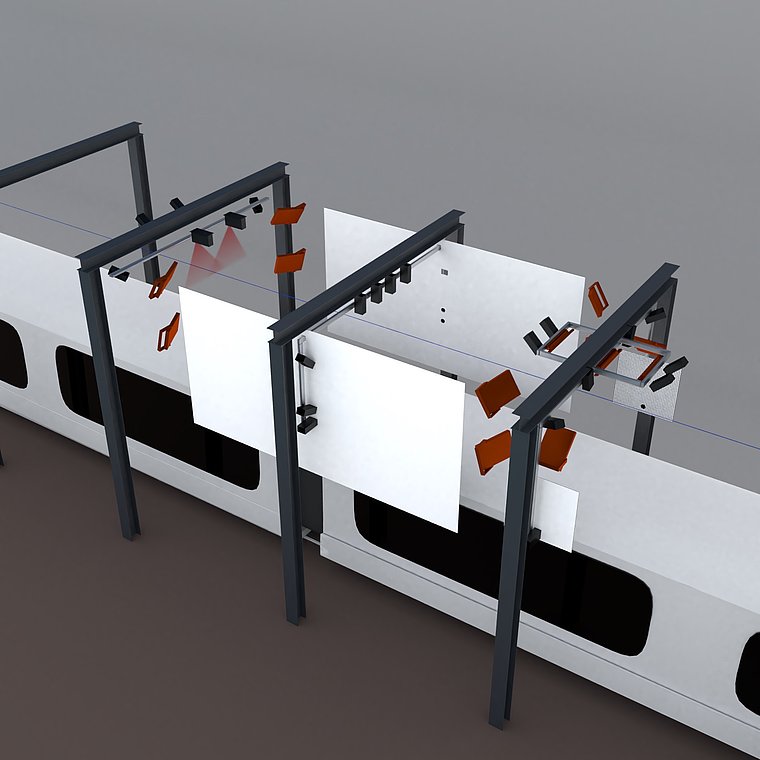
Always on the right track: Machine vision saves time and money in rail vehicle maintenance – PSI Technics
Automotive | Classification | Inspection
PSI Technics GmbH has developed a system that can be used to automate the maintenance of multiple-unit high-speed trains through visual inspection of the rooftop. The MVTec HALCON standard machine vision software ensures that defects are reliably detected.
To guarantee maximum safety and performance, technologies and systems need to be dependably maintained on a regular basis. This is especially true of modern rail vehicles, such as multiple-unit high-speed trains. Maintenance work should ensure the longest possible service life and minimize wear on the trains. Qualified technicians who undergo special visual training generally perform these tasks. However, these specialists need one thing above all else to carry out their maintenance work: time.
To perform visual inspections manually, the technicians must climb up onto the train roof. Before they can begin the inspection, however, the train and overhead line need to be grounded, a necessary precaution to prevent any high-voltage safety hazards for personnel. Because of the large number of required safety steps, this process is laborious and the inspection engineers have to cover long distances. To reduce the amount of work involved, it makes sense to automate the entire process, including grounding and diagnosis.
Defect inspection in transit
PSI Technics GmbH has developed a sophisticated, customizable technology for this purpose, consisting of a modern camera system and laser sensors. This system is able to supplement or even completely replace visual and manual tests and inspections. Known as DA-MI-KA, this camera-based roof inspection system records all damage to the roof structure of a rail vehicle as it passes by and sends the collected data directly to the DA-MI-KA Inspect analysis software. Thanks to automation, this helps detect problems at an early stage and thereby optimize the maintenance processes and make them safer.
A preliminary check is first carried out to determine whether the particular inspection is feasible for the DA-MI-KA system, based on selected, defined test components. Suitable diagnostic methods, processes, workflows, and requirements are then identified. The inspections include measuring the pantograph wearing strip, checking the surface of the roof, inspecting the pantograph, checking insulators, antennas, and screw connections, analyzing cables and conductor lines, and inspecting climate covers and other coverings.
Reliably detecting all damage and defects
Two side-mounted cameras and one camera positioned over the roof contactlessly record images of the train surface as the train passes by. The digital image information is processed by the MVTec HALCON standard machine vision software. Relevant image information regarding the roof’s surface is selected, thanks to 2D machine vision technologies. Based on the reduced data, possible damage to the surface is detected and classified in subsequent processing steps. The classified defects are then marked as such and made available to the user. This makes it possible to reliably detect and precisely locate many different types of damage and defects on the roof structure, including indentations, spalling, cracks, single fiber or strand breakage, deformation, displacement, loose bolt connections, contact burns, and missing components.
After the recorded images have been processed and analyzed by the MVTec HALCON-based DA-MI-KA inspect software, the inspection results are delivered within 10 minutes and displayed via a web interface. Each type of rail vehicle is individually taught in, and the measurement workflow is flexibly adapted to the specific train. The data identified by DA-MI-KA can be used for many different purposes – for example, to generate statistics, detect creeping wear and tear, network trains and locations, conduct condition-based maintenance, teach in additional multiple-unit trains within a series, and evaluate data to optimize the process.
Summary
The automated camera-based roof inspection system (DA-MI-KA) from PSI Technics and the integrated MVTec HALCON machine vision software help optimize the maintenance of rail vehicles, thus guaranteeing safe operation and maximum availability. The system also significantly improves the quality and reliability of inspection measures and greatly reduces rail service downtimes. Thanks to end-to-end automation, the inspection time can be shortened from 1.5 hours to as little as 10 minutes. Finally, there is no need for the train to take up space in the maintenance shop, since the DA-MI-KA inspection process can be carried out elsewhere. As a result, the railcar does not have to enter the shop and can remain in service throughout the inspection. Read the full story here at vision-systems.com.
